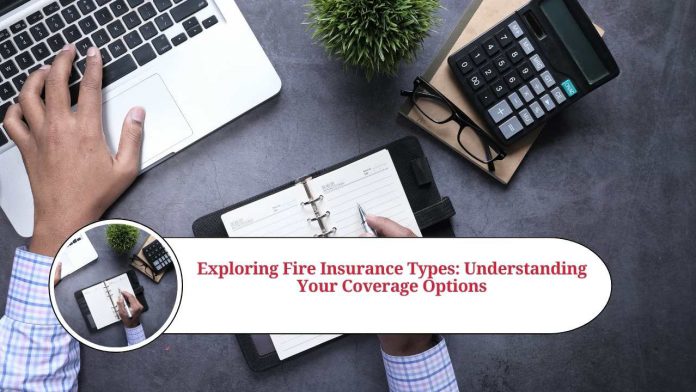Fire insurance is a crucial component of property insurance, offering financial protection against the devastating losses caused by fire incidents. However, not all fire insurance policies are the same. In this blog, we will delve into the various types of fire insurance coverage available to property owners. By understanding the different types of fire insurance, you can make informed decisions about the coverage that best suits your needs.
Standard Fire Insurance:
Standard fire insurance provides basic coverage against fire-related damages. It typically covers the structure of the property and its contents, including furniture, appliances, and personal belongings. This type of insurance is a fundamental safeguard against fire accidents and is often required by mortgage lenders.
Comprehensive Fire Insurance:
Comprehensive fire insurance goes beyond the basic coverage offered by standard fire insurance. It provides additional protection against a wider range of perils, such as explosions, lightning strikes, riots, and civil commotions. With comprehensive fire insurance, property owners can have peace of mind knowing they are protected from various risks that can lead to fire damage.
Replacement Cost Coverage:
Replacement cost coverage is an essential aspect of fire insurance. It ensures that the insured property is covered for its full replacement value in case of fire damage. This type of coverage considers the current market value and cost of replacing the damaged property with new items of similar quality. It is particularly beneficial for property owners who want to recover the full value of their assets in the event of a fire.
Actual Cash Value Coverage:
Actual cash value coverage takes into account the depreciation of the insured property when determining the claim settlement. It considers the current market value of the damaged items, taking into consideration their age, condition, and wear and tear. While actual cash value coverage may result in a lower claim payout compared to replacement cost coverage, it can still provide financial assistance for the replacement or repair of damaged property.
Named Perils Coverage:
Named perils coverage is a specific type of fire insurance that covers only the perils explicitly listed in the policy. The policyholder is protected against fire damage caused by those specified perils, such as lightning, explosion, or electrical short circuits. It is important to carefully review the named perils listed in the policy to ensure that the coverage aligns with the potential risks faced by the property.
All-Risk Coverage:
All-risk coverage, also known as comprehensive coverage, provides the broadest level of protection against a wide range of risks and perils, including fire. With all-risk coverage, the policyholder is covered for any perils that are not specifically excluded in the policy. It offers comprehensive and flexible coverage, giving property owners peace of mind knowing that they are protected from numerous potential threats.
Conclusion:
Fire insurance comes in various types, each offering different levels of protection and coverage options. Standard fire insurance provides basic coverage, while comprehensive fire insurance expands the scope of protection. Replacement cost coverage ensures the full replacement value of a damaged property, while actual cash value coverage considers depreciation. Named perils coverage focuses on specified perils, while all-risk coverage offers comprehensive protection. Understanding these fire insurance types is crucial for property owners to select the most appropriate coverage based on their specific needs. Consult with insurance professionals to assess your requirements and choose the fire insurance policy that offers optimal protection for your valuable assets.
Read more useful content:
Frequently Asked Questions
Q1: What is fire insurance?
A1: Fire insurance is a type of property insurance that provides coverage against losses caused by fire-related incidents. It helps protect property owners financially by compensating for damages to the structure and contents of the property resulting from fire.
Q2: What is the difference between standard fire insurance and comprehensive fire insurance?
A2: Standard fire insurance provides basic coverage against fire damages, while comprehensive fire insurance offers broader protection against a range of perils, including fire, explosions, riots, and civil commotions. Comprehensive fire insurance provides additional peace of mind by covering a wider array of risks.
Q3: What is replacement cost coverage in fire insurance?
A3: Replacement cost coverage is a type of fire insurance that ensures the full replacement value of the damaged property. It takes into account the current market value and cost of replacing the items with new ones of similar quality. This coverage helps property owners recover the full value of their assets in the event of a fire.
Q4: How does actual cash value coverage differ from replacement cost coverage?
A4: Actual cash value coverage considers the depreciation of the damaged property when determining the claim settlement. It takes into account factors such as age, condition, and wear and tear, resulting in a lower claim payout compared to replacement cost coverage. Actual cash value coverage still provides financial assistance for the repair or replacement of damaged property.
Q5: What is named perils coverage in fire insurance?
A5: Named perils coverage is a specific type of fire insurance that covers only the perils explicitly listed in the policy. Policyholders are protected against fire damage caused by those specified perils, such as lightning, explosion, or electrical short circuits. It’s important to review the named perils listed in the policy to ensure the coverage aligns with potential risks.
Q6: What is all-risk coverage in fire insurance? A6: All-risk coverage, also known as comprehensive coverage, provides the broadest level of protection against a wide range of risks and perils, including fire. With all-risk coverage, the policyholder is covered for any perils that are not specifically excluded in the policy. It offers comprehensive and flexible coverage, providing property owners with extensive protection.
Q7: Can I have multiple types of fire insurance coverage?
A7: Yes, depending on your needs and the policies offered by insurance providers, it is possible to have multiple types of fire insurance coverage. You can discuss your requirements with insurance professionals to determine the combination of coverage options that best suit your property and risk profile.
Q8: Do I need fire insurance if I already have homeowner’s insurance?
A8: While homeowner’s insurance may include some coverage for fire damages, it’s important to review the specifics of your policy. Fire insurance provides specialized coverage focused on fire-related incidents, ensuring adequate financial protection specifically against fire damage. Consider evaluating your existing coverage and assessing if additional fire insurance is necessary.
Q9: Can I switch my fire insurance coverage if I find a better option?
A9: Yes, you can switch your fire insurance coverage to another insurance provider or adjust your policy based on your changing needs. However, it’s important to carefully review the terms, conditions, and coverage limits of any new policy before making the switch to ensure that it meets your requirements.
Q10: How do I determine the right fire insurance coverage for my property?
A10: Assessing the right fire insurance coverage for your property involves considering factors such as the value of your assets, the location of your property, and your risk tolerance. Consulting with insurance professionals or agents can help you evaluate your needs and select the appropriate fire insurance coverage that provides adequate protection for your property against fire-related risks.




















